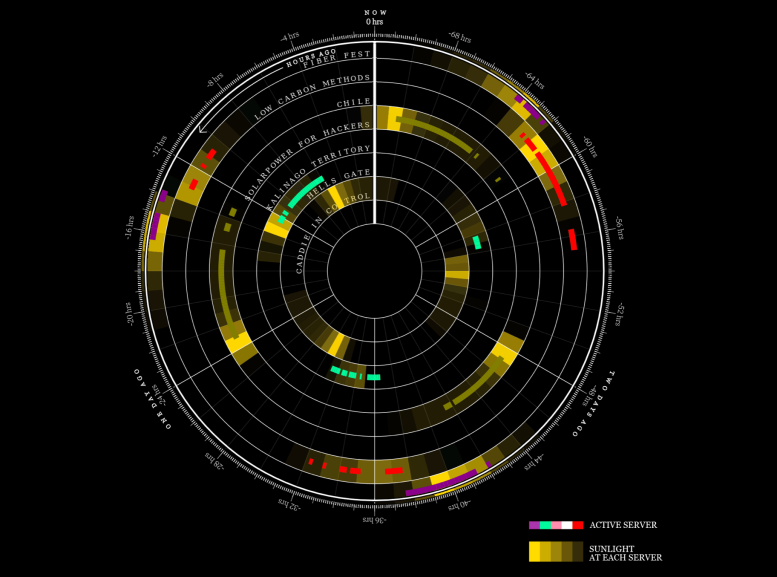Could the Internet Be Driven by Climate-Friendly “Natural Intelligence?”

Map of solar exposure over 24 hours at each Solar Protocol sun-powered network server. Credit: Tega Brain, Benedetta Piantella
Global network of solar-powered servers shows how.
The energy requirements of the Internet, the devices and systems using it and the servers that support it are responsible for greenhouse gas emissions equal to that of the global airline industry, and this carbon cost is growing rapidly with the expansion of blockchain-enabled transactions: The carbon footprint of a single Ethereum transaction is equivalent to nearly 329,000 credit card transactions.
A new project, Solar Protocol, developed by a team of researchers at the NYU Tandon School of Engineering, aims both to spotlight how this transglobal trafficking of data through the web is a major consumer of energy and driver of climate change, and to offer a potential solution.
On Tuesday, March 15, 2022, the project, initially supported by the Eyebeam Rapid Response for a Better Digital Future program, and the Code for Science & Society Digital Infrastructure Incubator, receives the Mozilla Creative Media Award from Mozilla, which supports internet health through development of open-source technologies in such areas as online privacy, inclusion and decentralization. Mozilla offers the award to people and projects that illuminate how to reimagine data in a way that shifts power away from big tech platforms and toward individuals and communities.
Developed by NYU Tandon Professors of Technology Culture and Society Tega Brain, who is also an assistant industry professor of integrated digital media, and Benedetta Piantella, a member of the Center for Urban Science and Progress (CUSP); and Adjunct Professor Alex Nathanson, Solar Protocol comprises a web platform hosted across a network of solar-powered servers set up in locations around the world. Besides being a workable system with implications for future servers, it constitutes a global installation that spotlights the politics of the web and different ways to track web traffic.
In stark contrast to large-scale, high-volume web services that algorithmically direct network traffic to whichever server gives the quickest response time, usually the closest geographically, Solar Protocol, with about a dozen volunteer-run server nodes around the world, uses the sun’s interaction with Earth as the cornerstone. How the sun shapes daily behaviors, seasonal activities and the decision-making of almost all life forms becomes the “logic” used to automate decisions in the digital network.
“Solar Protocol is a great opportunity for us as artists to foreground issues of climate change and how technology is driving it,” said Brain. “The project has catalyzed conversations about AI and automation, since in-network user traffic is decided by solar energy, so we are using intelligence from natural and dynamic versus a data-driven machine learning model; it’s an alternative proposition. Why not think of planetary limits as intelligence? Afterall, they will shape the future of life on earth whether we like it or not”
The network takes into consideration the fact that servers, each powered by photovoltaic cells, are located in different time zones and seasons, with different sun exposure and weather systems, and directs internet traffic to wherever the sun is shining. When a browser makes a request to see the Solar Protocol website, it is sent to whichever server in the network is generating the most energy.
“This is in no way an alternative to the internet, so the goal here is not to scale it up. But we are publishing the system as an open standard, which means, theoretically, anyone could launch a similar network — say, a network of art museums,” said Piantella.
Brain pointed out that the project also addresses the language of the Internet, and how we speak of it in terms suggesting it has little to do with the concrete realities of our physical environment.
“We talk about the internet as the cloud, for example, and we tend to use the language of magic to describe it, making no connection to how resource intensive it really is,” she said. “So, people who get involved in the project as server stewards, become very much in touch with its material reality, and what it takes to set up a server powered by the sun. You start making different design decisions; you think about planetary limits and rethink the politics of the internet.”
Added Kofi Yeboah, Creative Media Awards Program Officer at Mozilla, “In our connected world, conversations about power, about inclusion and exclusion, and about ownership often come down to one thing: data. How data is collected, managed, and trains AI systems has an impact on billions of lives. But that impact is often invisible. Creative Media Awards like Solar Protocol make the invisible visible, revealing how data can impact everything from the environment to personal safety. The Creative Media Awards also offer a way forward, modeling ways that data can be better stewarded to empower people and communities.”
An educational component of the project is through the VIP (Vertically Integrated Projects) initiative at NYU Tandon, allowing students to participate in analysis of the network’s functional cycle.
Solar Protocol includes several collaborators from a range of communities, including faculty members in Chile, and arts, cultural and community-based organizations in multiple areas and Indigenous territories in the Caribbean, Australia, and Kenya.
No comments:
Post a Comment